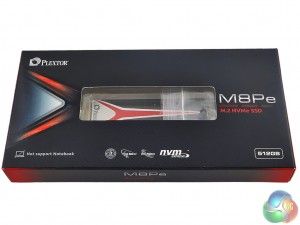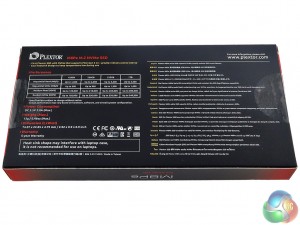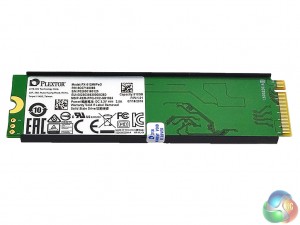The M8Pe(G) comes in a pleasant looking box which mimics the finish of the drive's heatsink. The box front has a rectangle cut into it to expose the drive inside which sits in an easy to open blister pack. Along with the drive's name and branding, there is a small capacity label and a number of icons showing some of the drive's features.
The only other thing in with the drive is a small mounting screw sealed inside a small resealable plastic bag.
The rear of the box has a table showing the whole drive range's capacity offerings' sequential and random read/write performance along with a small list of specifications. Along with these are multilingual statements about the NVMe interface.
Try as we might, we couldn't get the heatsink off our review sample to show the components underneath. It was stuck like the proverbial limpet on top of the NAND, but going on photographs of the M8PeGN we know how the drive is laid out.
All the components of the 512GB drive sit on one side of the PCB. Sitting nearest to the mounting screw end of the board are two packages of Toshiba 15nm MLC Toggle NAND. Next up, there is a single 512MB LPDDR3 cache IC and finally the Marvell 88SS1093 controller.
Built on a 28nm process, the 8-channel 88SS1093 is the company's first NVMe capable controller and it can support TLC/MLC/SLC as well as 3D NAND. To enhance TLC NAND's reliability it also features Marvell's 3rd-genaration LDPC technology.
 KitGuru KitGuru.net – Tech News | Hardware News | Hardware Reviews | IOS | Mobile | Gaming | Graphics Cards
KitGuru KitGuru.net – Tech News | Hardware News | Hardware Reviews | IOS | Mobile | Gaming | Graphics Cards







“AS SSD is another test where the M8Pe(G) scores highly. It’s interesting to contrast the drive with the last PCIe interfaced Plextor drive we looked at – the M6e Black Edition. It’s a sign of how far SSD technology has progressed in the year since the M6e was launched that its performance is totally eclipsed by the M8Pe(G).”
The M6e is limited to pcie 2.0×2 lanes, so comparing that to the m8pe which is pcie 3.0×4 is apples and oranges…you can’t really determine if the performance jump is due to more lanes, better nand, a better controller or all of them.
it’s easy to get here in the U.S., and it’s the cheapest of the high performance pcie 3.0×4 m.2 drives with the 512GB m.2 version, like in the review, going for $239 USD(€218/£197) on newegg
Thanks for pointing that out. I have updated the “hard to find” comment to point out that it is in reference to the UK market, at the time of writing.
Just a quick question. Do those SSDs need UEFI bios to work or they will work properly even with motherboards having legacy BIOS? Thanks in advance!